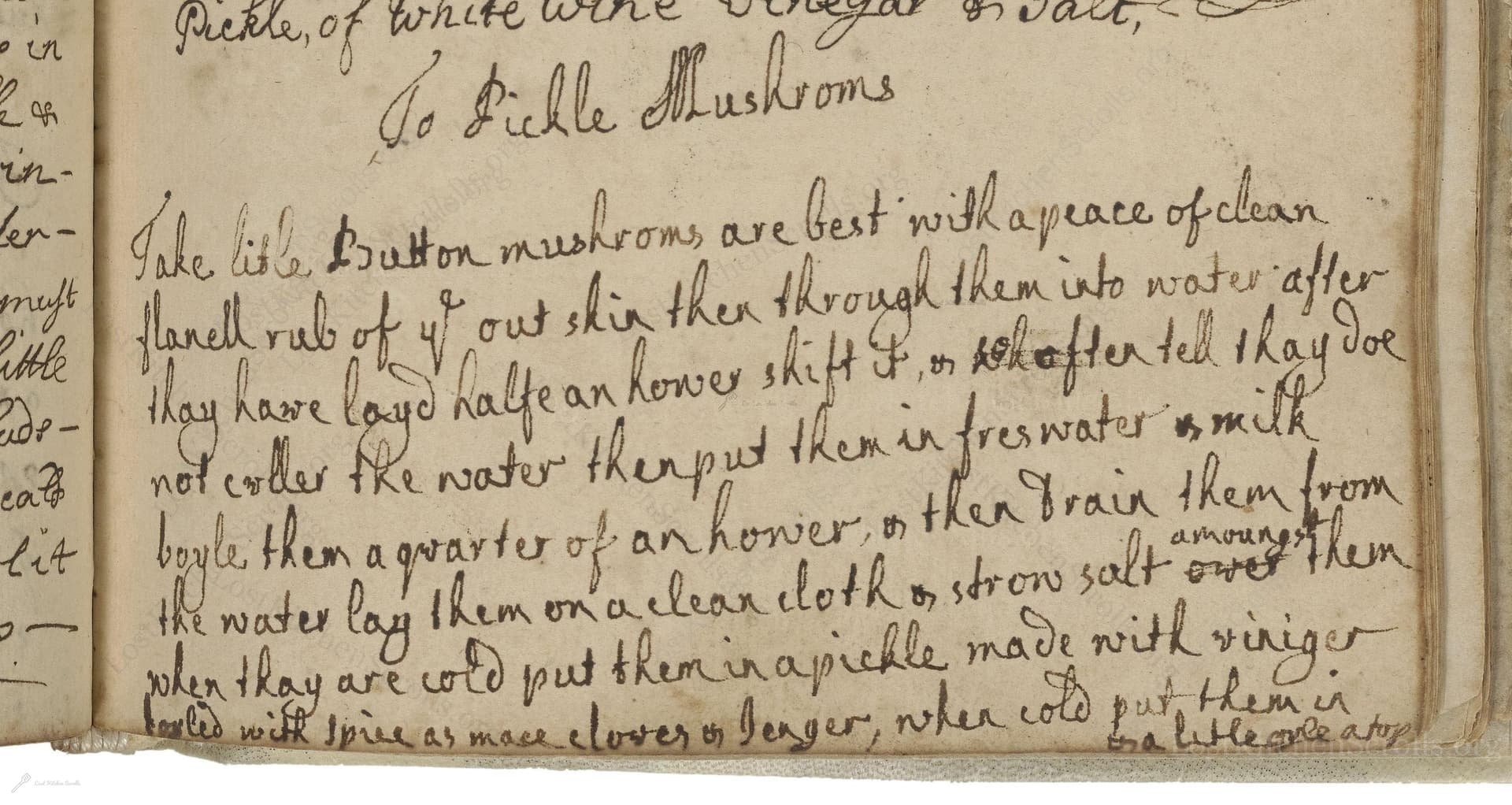To Pickle Mushrooms
From the treasured pages of Cook-book of Margaret Turner
Written by Margaret Eyre

To Pickle Mushrooms
"Take litle Butter.n mushroms are best with a peace of clean flanell rub of ye out skin then through them into water after they have layd halfe an hower shift ym & so often till they doe not coller the water then put them in freswater & milk boyle them a quarter of an hower, & then train them from the water lay them on a clean cloth, & strow salt over amongst them when they are cold put them in a pickle made with viniger boyled with spice as mace cloves & ginger, when cold put them in be a litle oyle a top"
Note on the Original Text
Early modern English recipes rely on brief, almost shorthand-like instructions, assuming the reader's practical kitchen knowledge. Words like 'boyle' (boil), 'flanell' (flannel), and 'train' (drain) reflect 18th-century spelling and terminology, while the lack of precise measures or times expected the skilled housewife to use intuition. Punctuation is sparse, and sentences are long and flowing, much like the oral traditional of passing down cooking wisdom.

Title
Cook-book of Margaret Turner (1709)
You can also click the book image above to peruse the original tome
Writer
Margaret Eyre
Era
1709
Publisher
Unknown
Background
Step into the refined world of early 18th-century cookery with Margaret Eyre, where recipes are whispered secrets and culinary wonders await. From hearty roasts to delicate sweets, this charming tome serves up inspiration fit for the tables of historic England.
Kindly made available by
Folger Shakespeare Library
This recipe comes from Margaret Eyre's manuscript, dated circa 1709—a time when preserving food was essential, and recipes were frequently handwritten for household, not professional, use. Pickling mushrooms ensured they could be enjoyed out of season and spiced vinegars helped mask any mustiness from mushrooms, while the use of milk in boiling was thought to sweeten and whiten the fungi. Early 18th-century households prized such pickles for their flavor and as signs of domestic accomplishment. The recipe reflects a period just before the Industrial Revolution, with women of means carefully directing the preservation of garden produce.

Historically, the cook used a piece of clean flannel to clean mushrooms, earthenware bowls for soaking, and an iron or copper pot for boiling. Mushrooms were drained on linen or a cloth, while the vinegar would have been boiled with spices in a small pan over a fire. Pickling was done in glazed ceramic or glass jars, and oil was sometimes poured from a small jug. No thermometers or standardized measurements—just practiced hands and sharp eyes.
Prep Time
30 mins
Cook Time
15 mins
Servings
6
We've done our best to adapt this historical recipe for modern kitchens, but some details may still need refinement. We warmly welcome feedback from fellow cooks and culinary historians — your insights support the entire community!
Ingredients
- 1 lb small button mushrooms
- Water, as needed
- 2/3 cup whole milk
- 1/2–1 tsp fine sea salt
- 2 cups white wine vinegar (or distilled white vinegar)
- 3-4 whole cloves
- 1-2 blades mace (or 1/2 tsp ground mace as substitute)
- 1 small piece of fresh ginger (about 3/4 inch, sliced)
- 1-2 tbsp mild oil (such as sunflower or light olive oil)
Instructions
- Begin with small button mushrooms, about 1 pound.
- Using a clean cloth (flannel if you wish to feel authentic), gently rub off the outer skin from each mushroom.
- Place the cleaned mushrooms into a bowl of water and let them soak for 30 minutes.
- Change the water several times until the water remains clear, indicating all grit has been removed.
- Fill a saucepan with fresh water and enough milk—about 1 1/4 cups water to 2/3 cup milk—to cover the mushrooms, and boil them gently for about 15 minutes.
- Drain the mushrooms, spread them out on a clean towel, and sprinkle them lightly with 1/2 to 1 teaspoon of salt.
- Allow them to cool.
- Meanwhile, make a pickling liquid: combine 2 cups white wine vinegar with a few whole cloves, several pieces of mace, and a small thumb of fresh ginger, sliced.
- Bring this mixture to a boil, then let it cool completely.
- Place the cooled mushrooms into sterilized jars, pour the cooled spiced vinegar over to cover, and finish with a thin layer of mild oil (such as sunflower oil) atop the vinegar to help preserve.
- Seal tightly.
- These pickled mushrooms are ready after a few days and should be refrigerated for modern food safety.
Estimated Calories
30 per serving
Cooking Estimates
It takes about half an hour to prepare the mushrooms by cleaning, soaking, then draining them. Cooking the mushrooms takes about 15 minutes. Total prep and cook time is around 45 minutes. This recipe makes about 6 servings. Each serving has around 30 calories, as mushrooms and vinegar are both very low in calories.
As noted above, we have made our best effort to translate and adapt this historical recipe for modern kitchens, taking into account ingredients nowadays, cooking techniques, measurements, and so on. However, historical recipes often contain assumptions that require interpretation.
We'd love for anyone to help improve these adaptations. Community contributions are highly welcome. If you have suggestions, corrections, or cooking tips based on your experience with this recipe, please share them below.
Join the Discussion
Rate This Recipe
Dietary Preference
Main Ingredients
Occasions

Den Bockfisch In Einer Fleisch Suppen Zu Kochen
This recipe hails from a German manuscript cookbook compiled in 1696, a time whe...

Die Grieß Nudlen Zumachen
This recipe comes from a rather mysterious manuscript cookbook, penned anonymous...

Ein Boudain
This recipe comes from an anonymous German-language manuscript cookbook from 169...

Ein Gesaltzen Citroni
This recipe, dating from 1696, comes from an extensive anonymous German cookbook...
Browse our complete collection of time-honored recipes



